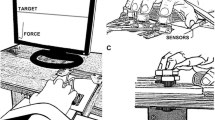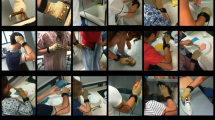Abstract
A number of analyses associated with the uncontrolled manifold (UCM) hypothesis have been used recently to investigate stability of actions across populations. We explored whether some of those methods have an advantage for clinical studies because they require fewer trials to achieve consistent findings. We compared the number of trials needed for the analysis of inter-trial variance, analysis of motor equivalence, and analysis in the space of referent coordinates. Young healthy adults performed four-finger accurate force production tasks under visual feedback with the right (dominant) and left hand over three days. Three methods [analytical (M1), experimental (M2), and cumulative mean (M3) methods] were used to define the minimal number of trials required to reach certain statistical criteria. Two of these methods, M1 and M2, showed qualitatively similar results. Fewer trials (M1: 5–13, M2: 4–10) were needed for analysis of motor equivalence compared to inter-trial variance analysis (M1: 14–24, M2: 10–14). The third method (M3) showed no major differences among the outcome variables. The index of synergy in the inter-trial variance analysis required a very small number of trials (M1, M2: 2–4). Variables related to referent coordinates required only a few trials (under 3), whereas the synergy index in this analysis required the largest number of trials (M1: 24–34, M2: 12–16). This is the first study to quantify the number of trials needed for UCM-based methods of assessing motor coordination broadly used in clinical studies. Clinical studies can take advantage of specific recommendations based on the current data regarding the number of trials needed for each analysis thus allowing minimizing the test session duration without compromising data reliability.



Similar content being viewed by others
References
Ambike S, Mattos D, Zatsiorsky VM, Latash ML (2016) Synergies in the space of control variables within the equilibrium-point hypothesis. Neurosci 315:150–161
Bernstein NA (1967) The co-ordination and regulation of movements. Pergamon Press, Oxford
Cuadra C, Bartsch A, Tiemann P, Reschechtko S, Latash ML (2018) Multi-finger synergies and the muscular apparatus of the hand. Exp Brain Res 236(5):1383–1393
de Freitas PB, Freitas SMSF, Lewis MM, Huang X, Latash ML (2018) Stability of steady hand force production explored across spaces and methods of analysis. Exp Brain Res. https://doi.org/10.1007/s00221-018-5238-y
Falaki A, Huang X, Lewis MM, Latash ML (2017a) Dopaminergic modulation of multi-muscle synergies in postural tasks performed by patients with Parkinson’s disease. J Electromyogr Kinesiol 33:20–26
Falaki A, Huang X, Lewis MM, Latash ML (2017b) Motor equivalence and structure of variance: multi-muscle postural synergies in Parkinson’s disease. Exp Brain Res 235:2243–2258
Falaki A, Jo HJ, Lewis MM, O’Connell B, De Jesus S, McInerney J, Huang X, Latash ML (2018) Systemic effects of deep brain stimulation on synergic control in Parkinson’s disease. Clin Neurophysiol 129(6):1320–1332
Feldman AG (1980) Superposition of motor programs. I. Rhythmic forearm movements in man. Neurosci 5:81–90
Feldman AG (1986) Once more on the equilibrium-point hypothesis. J Mot Behav 18:17–54
Feldman AG (2015) Referent control of action and perception: challenging conventional theories in behavioral science. Springer, New York
Furmanek M, Solnik S, Piscitelli D, Rasouli O, Falaki A, Latash ML (2018) Synergies and motor equivalence in voluntary sway tasks: the effects of visual and mechanical constraints. J Mot Behav. https://doi.org/10.1080/00222895.2017.1367642
Hamill J, McNiven SL (1990) Reliability of selected ground reaction force parameters during walking. Hum Mov Sci 9(2):117–131
Harris CM, Wolpert DM (1998) Signal-dependent noise determines motor planning. Nature 394(6695):780–784
Hogan N, Sternad D (2007) On rhythmic and discrete movements: reflections, definitions and implications for motor control. Exp Brain Res 181(1):13–30
James CR, Herman JA, Dufek JS, Bates BT (2007) Number of trials necessary to achieve performance stability of selected ground reaction force variables during landing. J Sport Sci Med 6(1):126–134
Jo HJ, Park J, Lewis MM, Huang X, Latash ML (2015) Prehension synergies and hand function in early-stage Parkinson’s disease. Exp Brain Res 233:425–440
Jo HJ, Maenza C, Good DC, Huang X, Park J, Sainburg RL, Latash ML (2016) Effects of unilateral stroke on multi-finger synergies and their feed-forward adjustments. Neurosci 319:194–205
Jo HJ, Mattos D, Lucassen EB, Huang X, Latash ML (2017) Changes in multidigit synergies and their feed-forward adjustments in multiple sclerosis. J Motor Beh 49:218–228
Krishnamoorthy V, Latash ML, Scholz JP, Zatsiorsky VM (2003) Muscle synergies during shifts of the center of pressure by standing persons. Exp Brain Res 152:281–292
Latash ML (2010) Motor synergies and the equilibrium-point hypothesis. Mot Control 14:294–322
Latash ML (2012) The bliss (not the problem) of motor abundance (not redundancy). Exp Brain Res 217:1–5
Latash ML (2016) Towards physics of neural processes and behavior. Neurosci Biobehav Rev 69:136–146
Latash ML (2017) Biological movement and laws of physics. Mot Control 21:327–344
Latash ML, Huang X (2015) Neural control of movement stability: Lessons from studies of neurological patients. Neurosci 301:39–48
Latash ML, Scholz JP, Schöner G (2002) Motor control strategies revealed in the structure of motor variability. Exerc Sport Sci Rev 30:26–31
Latash ML, Levin MF, Scholz JP, Schöner G (2010) Motor control theories and their applications. Medicina 46:382–392
Leone FC, Nottingham RB, Nelson LS (1961) The folded normal distribution. Technometrics 3:543–550
Lewis MM, Lee EY, Jo HJ, Du G, Park J, Flynn MR, Kong L, Latash ML, Huang X (2016) Synergy as a new and sensitive marker of basal ganglia dysfunction: a study of asymptomatic welders. Neurotoxicology 56:76–85
Martin JR, Budgeon MK, Zatsiorsky VM, Latash ML (2011) Stabilization of the total force in multi-finger pressing tasks studied with the ‘inverse piano’ technique. Hum Mov Sci 30:446–458
Mattos D, Latash ML, Park E, Kuhl J, Scholz JP (2011) Unpredictable elbow joint perturbation during reaching results in multijoint motor equivalence. J Neurophysiol 106:1424–1436
Mattos D, Schöner G, Zatsiorsky VM, Latash ML (2015) Motor equivalence during accurate multi-finger force production. Exp Brain Res 233:487–502
Müller H, Sternad D (2003) A randomization method for the calculation of covariation in multiple nonlinear relations: illustrated with the example of goal-directed movements. Biol Cybern 89:22–33
Olafsdottir H, Yoshida N, Zatsiorsky VM, Latash ML (2005) Anticipatory covariation of finger forces during self-paced and reaction time force production. Neurosc Lett 381(1–2):92–96
Park J, Zatsiorsky VM, Latash ML (2010) Optimality vs. variability: an example of multi-finger redundant tasks. Exp Brain Res 207:119–132
Park J, Wu YH, Lewis MM, Huang X, Latash ML (2012) Changes in multifinger interaction and coordination in Parkinson’s disease. J Neurophysiol 108:915–924
Park J, Lewis MM, Huang X, Latash ML (2013) Effects of olivo-ponto-cerebellar atrophy (OPCA) on finger interaction and coordination. Clin Neurophysiol 124:991–998
Parsa B, O’Shea DJ, Zatsiorsky VM, Latash ML (2016) On the nature of unintentional action: a study of force/moment drifts during multi-finger tasks. J Neurophysiol 116:698–708
Reschechtko S, Latash ML (2017) Stability of hand force production: I. Hand level control variables and multi-finger synergies. J Neurophysiol 118:3152–3164
Reschechtko S, Latash ML (2018) Stability of hand force production: II. Ascending and descending synergies. J Neurophysiol 120:1045–1060
Sainburg RL (2005) Handedness: differential specializations for control of trajectory and position. Exerc Sport Sci Rev 33:206–213
Scholz JP, Schöner G (1999) The uncontrolled manifold concept: Identifying control variables for a functional task. Exp Brain Res 126:289–306
Scholz JP, Kang N, Patterson D, Latash ML (2003) Uncontrolled manifold analysis of single trials during multi-finger force production by persons with and without Down syndrome. Exp Brain Res 153:45–58
Wu Y-H, Pazin N, Zatsiorsky VM, Latash ML (2012) Practicing elements vs. practicing coordination: changes in the structure of variance. J Mot Behav 44:471–478
Wu Y-H, Pazin N, Zatsiorsky VM, Latash ML (2013) Improving finger coordination in young and elderly persons. Exp Brain Res 226:273–283
Acknowledgements
The study was supported in part by NIH Grants NS082151 and NS095873.
Author information
Authors and Affiliations
Corresponding author
Electronic supplementary material
Below is the link to the electronic supplementary material.
Rights and permissions
About this article
Cite this article
Freitas, S.M.S.F., de Freitas, P.B., Lewis, M.M. et al. Quantitative analysis of multi-element synergy stabilizing performance: comparison of three methods with respect to their use in clinical studies. Exp Brain Res 237, 453–465 (2019). https://doi.org/10.1007/s00221-018-5436-7
Received:
Accepted:
Published:
Issue Date:
DOI: https://doi.org/10.1007/s00221-018-5436-7




